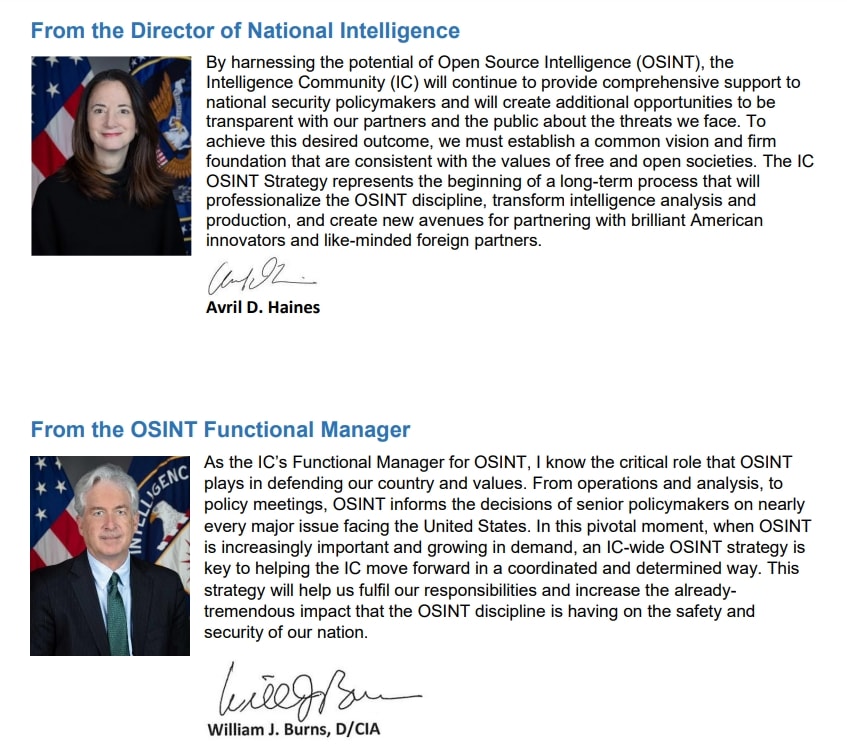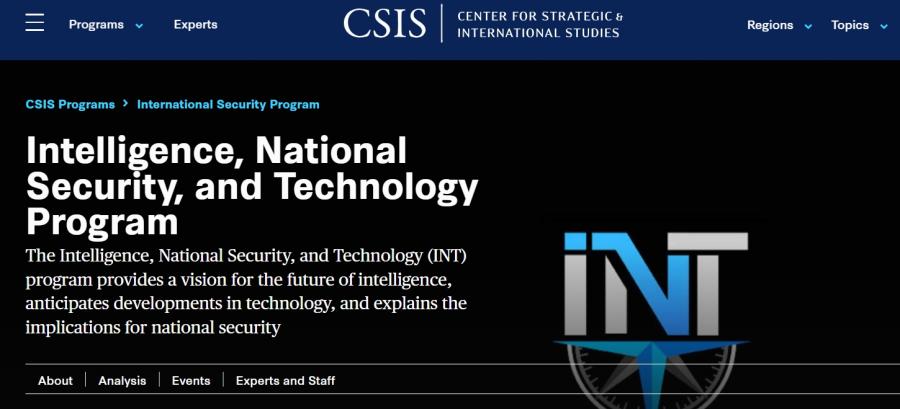OSINT for Homeland Security
The strategic imperative of Open-Source Intelligence (OSINT) within the defense and homeland security sectors is increasingly pronounced, especially in the context of the Intelligence Community’s OSINT Strategy for 2024-2026. This strategy emphasizes the indispensable role of OSINT in fortifying the United States’ defense posture against complex and evolving global threats. It underscores the necessity of integrating advanced OSINT methodologies to enhance military and intelligence operations.

Case Studies in OSINT for Homeland Security
The conflict in Ukraine has been a major source of OSINT reporting. Russian
warplanes that were shot down over Ukraine were able to be identified by the
markings on their aircraft, being matched to photos of them before the war. This
allowed a somewhat accurate picture of how many air casualties the Russian Air
Force had taken during the conflict. Along with this, OSINT sources have
geolocated battles and engagements of significance. Ukrainian retaliatory
attacks within Russia have been in the news lately, with a Russian oil depot in
Belgorod being attacked by low flying Ukrainian attack helicopters. Videos of
the plant on fire would circulate online with the locations of the depot being
confirmed through cross-referencing Google street view photos and the videos
shared. There have also been countless videos of destroyed tanks, armoured
vehicles and trucks that have given the world a picture of losses in the
conflict and of how modern combat will play out in wars without an absolute
advantage on one side.
The use of OSINT by the Ukrainian and Russian military is currently
unverified, with the fog of war in this conflict not being clear yet, we are
unable to confirm the use of OSINT until after this conflict ends.
Strategic Integration of OSINT in Homeland Security and Military Operations
The cornerstone of military strategic planning, intelligence, traditionally anchored in the acquisition of classified data, has been transformed by the advent of OSINT. Accessibility to a wide array of public and commercially available information sources, from digital media to satellite imagery, revolutionizes threat assessment and strategic planning. The ability to aggregate and analyze data from these diverse sources enables a comprehensive understanding of geopolitical dynamics and potential threats. Automated, consolidated OSINT platforms significantly streamline the assimilation of data into actionable intelligence, optimizing strategic decision-making and operational awareness.

OSINT’s Operational Impact on Homeland Security and the Emergence of Cognitive Warfare
In addition to enhancing situational awareness and facilitating real-time threat monitoring, OSINT plays a critical role in the domains of cyber and cognitive warfare. Cognitive warfare, aiming to influence, disrupt, or hijack the cognitive processing of information among both warfighters and the local population in contested environments, requires a nuanced understanding of information dissemination and influence mechanisms. Open-Source Intelligence provides the tools to monitor and analyze the information environment, identifying misinformation campaigns, psychological operations, and influence efforts that could affect military operations or homeland security posture. This dual capability in cyber and cognitive warfare domains underscores the value of OSINT in crafting comprehensive defense strategies that address both the digital and cognitive battlefields.
KIS(Knowlesys Intelligence System) employs advanced OSINT (Open Source Intelligence) technologies for homeland security departments as below
1. Automated Data Collection and Analysis: KIS employs AI and machine learning to automatically collect, filter, and analyze vast amounts of data from various sources, including social media, news sites, and public recordshttps://blog.mcafeeinstitute.com/articles/leveraging-advanced-osint-techniques-for-enhanced-investigative-outcomes.
2.Geospatial Intelligence (GEOINT): KIS integrates geospatial data with OSINT to provide location-based insights. This can be crucial for tracking movements and identifying hotspots.
3. Social Network Analysis: KIS maps and analyzes relationships and interactions within social networks to identify key influencers, potential threats, and patterns of behavior.
4. Dark Web Monitoring: KIS can access and monitor the dark web for illicit activities, providing early warnings about potential threats.
5. Real-Time Monitoring and Alerts: KIS offers real-time monitoring of various data sources and generate alerts for any suspicious or relevant activities.
6. Natural Language Processing (NLP): KIS employs advanced NLP technologies that can process and understand multiple languages, enabling the analysis of global data sources without language barriers.
7. Big Data Analytics: KIS can handle and analyze large datasets to identify trends, anomalies, and actionable intelligence.
These technologies help homeland security departments to proactively detect and respond to threats, ensuring a more secure environment.
Advancing OSINT through Data Analytics and Homeland Security Measures
The full potential of OSINT can only be realized with advanced data analytics and
stringent security measures. The integration of cutting-edge analytical
technologies and methodologies is essential for parsing through vast datasets to
extract actionable insights. Concurrently, implementing robust security
protocols is paramount to safeguard sensitive information and maintain
operational integrity amidst the challenges of cyber espionage and cognitive
manipulation.
The Intelligence Community’s proactive approach to OSINT, as articulated
in its latest strategy, reflects the growing recognition of its vital role in
modern defense and security frameworks. By leveraging OSINT in the realms of
cyber and cognitive warfare, the United States not only strengthens its defense
mechanisms but also pioneers the strategic application of open-source
intelligence in navigating the complexities of global security challenges. This
forward-thinking strategy positions the nation to effectively confront and
neutralize multifaceted threats in an increasingly interconnected and contested
world.

CSIS Launched Program on Intelligence, National Security, and Technology
On October 24, 2023, the Center for Strategic and International Studies (CSIS)
launched the Intelligence, National Security, and Technology (INT) Program, a
groundbreaking new effort that will provide leadership on the most difficult
issues in the field of intelligence, in particular how technology will shape the
future of national security.
CSIS launches this program as advancements in technology are making
previously impossible intelligence tasks possible. For example, monitoring
activity across the Pacific Ocean was once a matter of thousands of hours of
studying days-old imagery. Now, the combination of AI and constellations of
small satellites provides real-time alerts of naval activity. Today’s
open-source intelligence can take advantage of vast troves of new data to
provide unique insights. The United States is in a race to update encryption
standards before quantum computing makes current encryption obsolete and allows
adversaries to read decades of secrets.

Websites for OSINT in Homeland Security
Bellingcat
Bellingcat is an investigative platform that uses OSINT to uncover
hidden truths behind security issues. Homeland security agencies rely on
Bellingcat for in-depth reports and case studies related to international
terrorism, war crimes, and organized crime.
OSINT Framework
OSINT Framework is a comprehensive collection of links and tools
organized by category, helping homeland security professionals access relevant
data across multiple open-source platforms. It serves as a valuable resource for
locating publicly available information.
Public
Intelligence
Public Intelligence provides a variety of reports and documents related
to government policies, intelligence, and security threats. It is a crucial
resource for homeland security professionals seeking OSINT data on global and
domestic threats.
Darknetlive
Darknetlive tracks activities on dark web marketplaces, providing data
on illegal activities that may pose a threat to national security. Homeland
security agencies use it to monitor criminal activities related to drug
trafficking, terrorism financing, and weapons sales.
Conclusion
The use of OSINT for homeland security is essential for modern intelligence operations, providing cost-effective and comprehensive insights into potential threats. By leveraging OSINT tools, homeland security agencies can monitor social media, public data, and even dark web activities, allowing for early detection and rapid response. The integration of OSINT in security efforts helps build a proactive defense against terrorism, organized crime, and other threats, while adhering to legal and ethical standards of data collection. This approach strengthens overall national security measures in an increasingly digital world.